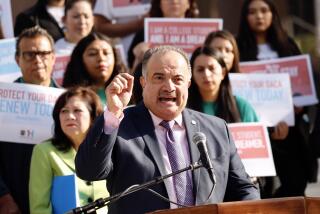Part-Time Faculty, Students Alike Are Cheated at Community Colleges
“NO OFFICE HOURS: PART-TIME INSTRUCTOR.”
Last semester I printed this message above the list of the two English classes I teach for my employer, the Los Angeles Community College District. After being paid an hourly wage for 19 years, I decided to respond quid pro quo: Fewer writing assignments and no out-of-class help for students.
But my resolve broke down when students came for help. It wasn’t their fault that they had chosen a part-time instructor. Along with more than 1,000 other college teachers, I’ve been kept in pedagogical peonage by a district that many of us believe uses our services to the detriment of the educational process.
The district has long maintained it needs “temporary employees” to staff classes that might have to be canceled if enrollment goes down. However, this cry for “flexibility” has turned into a tired fiction. The majority of part-timers, experts in our respective disciplines, have taught the same classes for years.
The resulting two-tier teaching staff is roughly divided between about 1,800 full-time to 1,600 part-time teachers. Both categories, equally qualified, credentialed and trained, share identical responsibilities, from textbook selection to final grades.
But there are enormous differences. Full timers, protected by a contract, are paid for a 30-hour week; many earn more than $40,000 by advancing on the salary schedule, and that’s for a 10-month school year. Part-timers, stringently restricted to only six hours of paid service per week, fall below the poverty level, earning, on average, a meager $7,000 annually. We receive no medical, dental or other insurance, and few qualify for benefits in the state teachers retirement system.
Yet, part-timers bring in the same state funds. The economic lifeblood of all public schools, ADA (average daily attendance) money, is paid for student enrollment and attendance, regardless of the status of teachers. Thus, college districts can show a “profit” by employing more part-timers.
How did this come to pass? In 1970 the state education code was changed to protect teachers by granting tenure after two years of satisfactory service. Legislators wanted to “enrich community life by giving permanency and continuity to the service of the teacher.” Quite the reverse occurred. As enrollment in community colleges grew, districts began to employ “temporary employees,” oxymoronically, as permanent part-timers.
And tenure, as matters stand, has been conferred on a chosen few. A typical example: The English Department at Valley College has hired only seven contract teachers in 20 years. Despite the district’s obligation to equal opportunity employment, all seven fiercely sought jobs have gone to white males.
We part-timers subsidize our more fortunate colleagues, and the college district practices “cost-effective” education. These savings, however, haven’t been passed on to the district’s nine campuses. Students, teachers and staff complain about badly maintained grounds, shabby buildings and the lack of support and library services.
The bottom line is that students are the real losers. Those enrolled, unwittingly, in a part-timer’s class can’t claim extra tutelage or counseling that they can from a full timer. Academically weak, foreign or special students need just an hour or so of undivided attention that can make a big difference in their lives.
Last year’s passage of Assembly Bill 1725 holds promise for teachers beginning their careers. Hailed a “landmark reform measure,” the bill will grant more than $140 million to California’s 107 community colleges, with up to 1,500 teachers slated for tenure.
As for us graying and, increasingly, cynical teachers, we must make sure the extra money earmarked for the L.A. district is wisely spent. The current budget shows a healthy surplus. Just a fraction of it could compensate us for one hour of conference time per class, in an office that’s assigned, not scrounged for by the instructor. But, most crucial, long-denied medical benefits must be paid for those without insurance, who often live dangerously close to the edge.
We may be part-time teachers, but we also happen to be full-time taxpayers. It’s our money that has been misallocated, our professional careers stunted and community college students poorly served by a counterproductive system.
More to Read
Sign up for Essential California
The most important California stories and recommendations in your inbox every morning.
You may occasionally receive promotional content from the Los Angeles Times.










